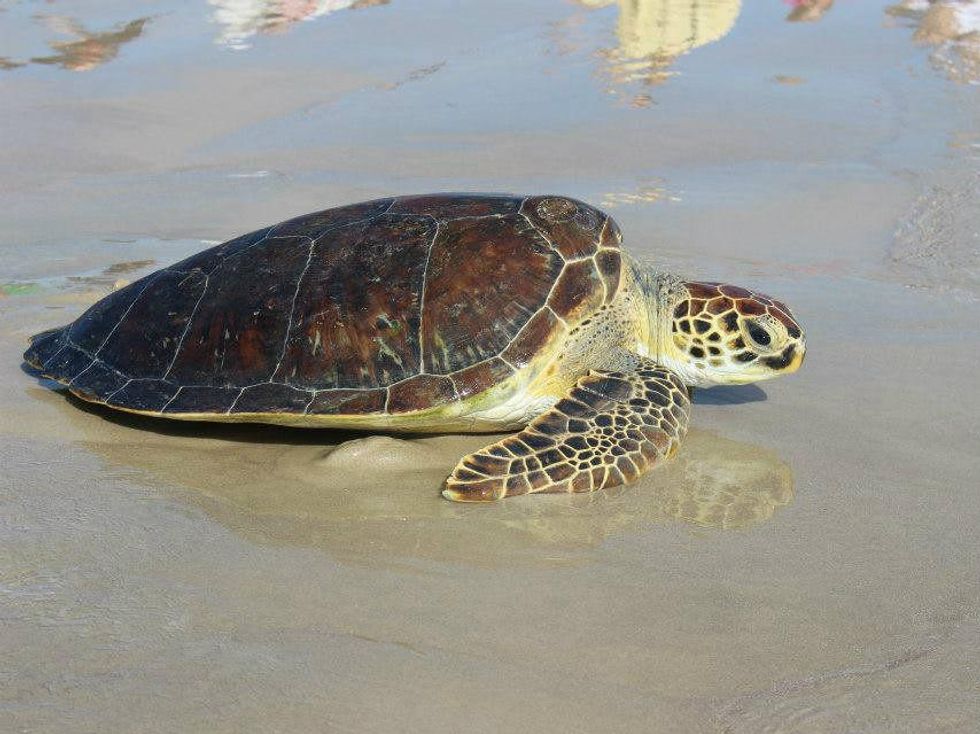Big Science
Invisibility cloaks and galaxies far away: Austin's 5 top science events of 2013
The scientific community constantly makes new discoveries and fascinating observations, improving our health, advancing our horizons, saving wild species, changing the technology that permeates our lives. This year saw its share of such announcements from scientists around the world, from the mildly interesting to nearly earth-shattering. Here are five of 2013's big science moments with ties to Austin.
In a galaxy far, far away …
University of Texas astronomers discovered farthest the galaxy from Earth whose distance can be confirmed definitively, publishing their finding in the October 24 issue of Nature.
Studying very distant galaxies helps scientists learn how galaxies change with time, which in turn contributes to understanding how the Milky Way came to be. Because light travels at a certain speed (about 186,000 miles per second), distant objects appear as they did in the past; thus, the farther away astronomers can push their observations, the further into the past they can see.
Researchers at the University of Texas developed a cloaking device just micrometers thick that can hide 3D objects in their natural environments.
Steven Finkelstein and the team selected this galaxy from approximately 100,000 discovered in the Hubble Cosmic Assembly Near-infrared Deep Extragalactic Legacy Survey (CANDELS). The team used colors from Hubble images to look for far-away galaxies, then used spectroscopy to measure the distances definitively— looking at how much the wavelengths of light shifted toward the red end of the spectrum as they traveled from the galaxy to Earth because of the expansion of the universe. Keck Observatory's Keck I telescope in Hawaii was used to measure this redshift phenomenon for the CANDELS galaxy (designated z8_GND_5296 at 7.51), indicating it came from only 700 million years after the Big Bang.
UT summons up an invisibility cloak
Researchers at the Cockrell School of Engineering at the University of Texas developed a cloaking device just micrometers thick that can hide three-dimensional objects from microwaves in their natural environments. The researchers presented their findings in March in the Institute of Physics and German Physical Society’s New Journal of Physics.
Previous cloaking studies have used metamaterials to bend incoming waves around an object, but this method, dubbed “mantle cloaking,” uses an ultrathin metallic metascreen to cancel out waves scattered off of the cloaked object. The overall effect is transparency and invisibility at all angles of observation, said electrical and computer engineering assistant professor Andrea Alú. Mantle cloaking could prove useful in defense, camouflaging items from radar and in health care. It could also eliminate interference between closely spaced antennas, improving cellular or radio communications in crowded environments.
The metascreen cloak consists of thin strips of copper tape attached to a flexible polycarbonate film a fraction of a millimeter thick, in a fishnet design. Researchers used it to cloak a cylindrical rod about 6 inches long.The same researchers successfully cloaked a 3D object last year using a method called “plasmonic cloaking,” which is more bulky. A key challenge still ahead is to use “mantle cloaking” to hide an object from visible light.
Killer seahorses
The head of a seahorse creates no wake in the water, which allows these slow, docile creatures to sneak up on their prey, according to marine scientists from UT. Brad Gemmell, research associate at the University of Texas Marine Science Institute, notes that copepods, tiny crustaceans that are the favored food of seahorses, can detect waves produced in advance of an attack and dash away at speeds of more than 500 body lengths per second — equivalent to a 6-foot person swimming underwater at 2,000 mph.
2013 saw record numbers of green and loggerhead sea turtle nests.
Using holography, the scientists revealed that the shape of a seahorse head minimizes the disturbance of water in front of its mouth, creating a “no wake zone." Thanks in part to this unique head shape, seahorses catch their intended prey 90 percent of the time. Seahorses rapidly rotate their heads upward and draw prey in with suction, a method called pivot feeding. It only works at distances of about 1 millimeter (about .04 inches), and a strike takes less than 1 millisecond. Bad news for copepods, which can respond to predator movements in 2 to 3 milliseconds.
Copepods are a major source of energy and anchor the marine food web, Gemmell said, so whatever affects copepods eventually affects humans.
Good news-bad news for sea turtles
Many Austinites who visit the coast have fond memories of attending the release of sea turtle hatchlings at Padre Island National Seashore. Some Austin residents even serve on the volunteer teams that patrol beaches looking for sea turtle nests. Those nests are here thanks to a decades-long, multinational effort. The first endangered Kemp’s ridley sea turtle returned to nest on a Texas beach in 1985, and the number of nests on our coast topped 200 in 2012. But in 2013, the number of ridley nests dropped to 153. Possible culprits are the 2010 BP oil spill, shrimp trawling in the Gulf, drought in Texas and flooding on the Mississippi —and likely a combination of some or all of these. That’s the bad news. The good news: 2013 saw record numbers of green and loggerhead sea turtle nests — 15 and 13 respectively, both representing significant jumps from past years.
"Science" tops all the words
Merriam-Webster Inc. announced its top 10 Words of the Year for 2013, based on those that were looked up the most online at Merriam-Webster.com and showed the greatest increase compared to last year. Some 100 million lookups a month revealed words behind the year’s biggest stories and the Word of the Year, with a 176 percent increase in lookups: "science."
That reflects a busy year in the field of science, but also a lot of controversy about scientific topics from climate change to textbooks (evolution, anyone?). The dictionary company might not be located in Austin (it’s in Massachusetts), but this city saw more than its fair share of those spirited debates this year.





